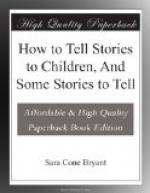HOW TO TELL STORIES TO CHILDREN
CHAPTER I
THE PURPOSE OF STORY-TELLING IN SCHOOL
Let us first consider together the primary matter of the aim in educational story-telling. On our conception of this must depend very largely all decisions as to choice and method; and nothing in the whole field of discussion is more vital than a just and sensible notion of this first point. What shall we attempt to accomplish by stories in the schoolroom? What can we reasonably expect to accomplish? And what, of this, is best accomplished by this means and no other?
These are questions which become the more interesting and practical because the recent access of enthusiasm for stories in education has led many people to claim very wide and very vaguely outlined territory for their possession, and often to lay heaviest stress on their least essential functions. The most important instance of this is the fervour with which many compilers of stories for school use have directed their efforts solely toward illustration of natural phenomena. Geology, zoology, botany, and even physics are taught by means of more or less happily constructed narratives based on the simpler facts of these sciences. Kindergarten teachers are familiar with such narratives: the little stories of chrysalis-breaking, flower-growth, and the like. Now this is a perfectly proper and practicable aim, but it is not a primary one. Others, to which at best this is but secondary, should have first place and receive greatest attention.
What is a story, essentially? Is it a text-book of science, an appendix to the geography, an introduction to the primer of history? Of course it is not. A story is essentially and primarily a work of art, and its chief function must be sought in the line of the uses of art. Just as the drama is capable of secondary uses, yet fails abjectly to realise its purpose when those are substituted for its real significance as a work of art, so does the story lend itself to subsidiary purposes, but claims first and most strongly to be recognised in its real significance as a work of art. Since the drama deals with life in all its parts, it can exemplify sociological theory, it can illustrate economic principle, it can even picture politics; but the drama which does these things only, has no breath of its real life in its being, and dies when the wind of popular tendency veers from its direction. So, you can teach a child interesting facts about bees and butterflies by telling him certain stories, and you can open his eyes to colours and processes in nature by telling certain others; but unless you do something more than that and before that, you are as one who should use the Venus of Milo for a demonstration in anatomy.
The message of the story is the message of beauty, as effective as that message in marble or paint. Its part in the economy of life is to give joy. And the purpose and working of the joy is found in that quickening of the spirit which answers every perception of the truly beautiful in the arts of man. To give joy; in and through the joy to stir and feed the life of the spirit: is not this the legitimate function of the story in education?




